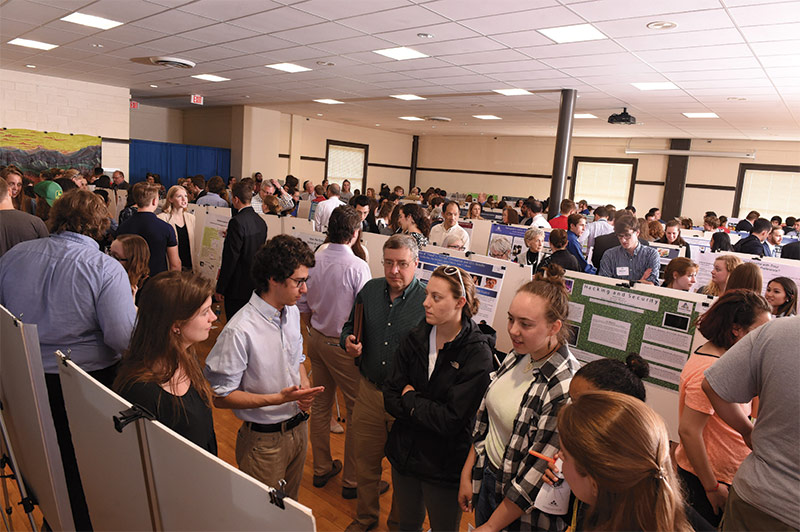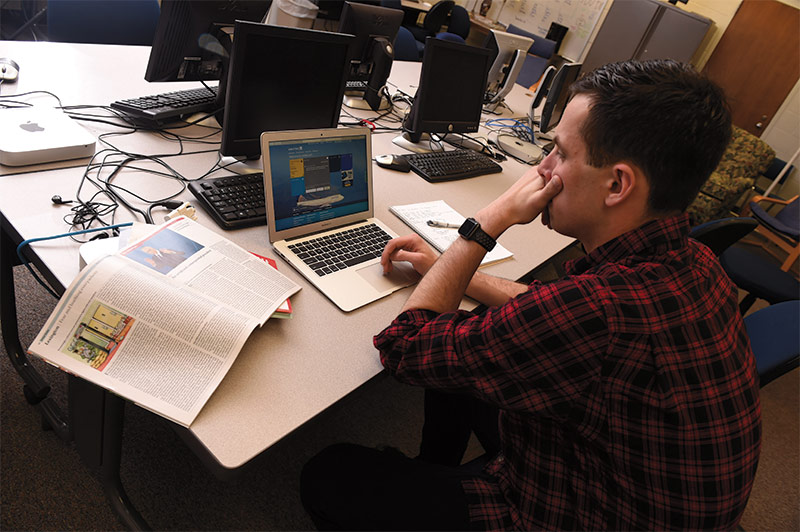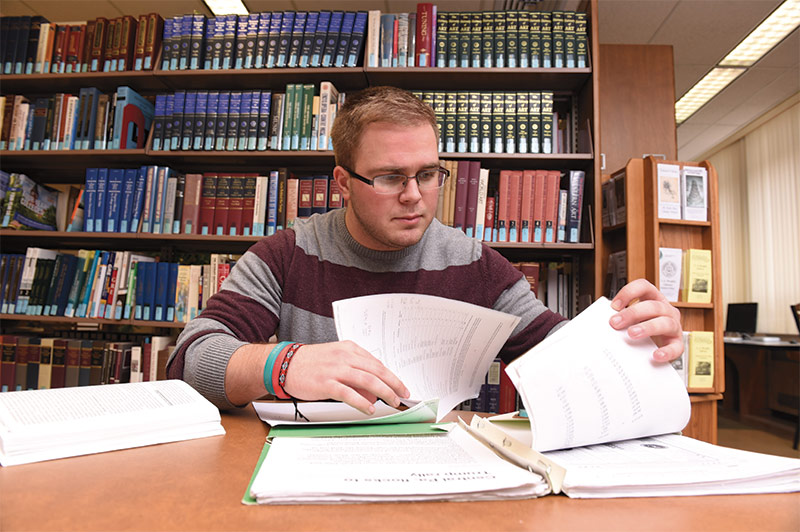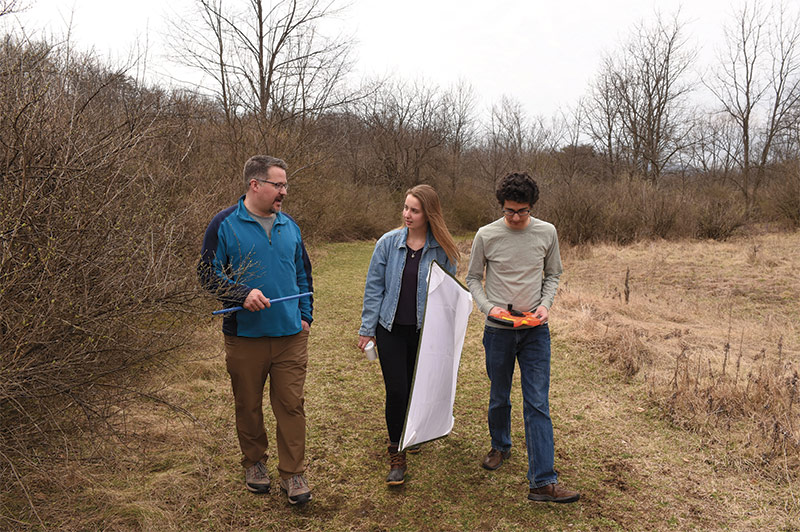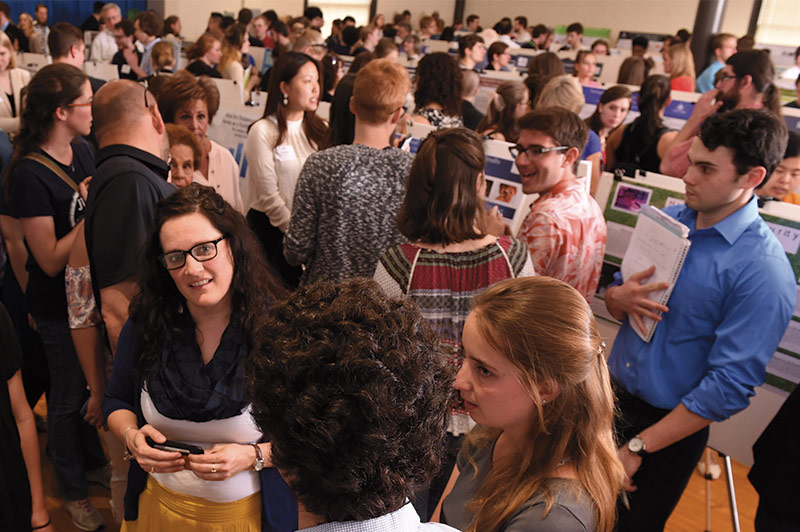Liberal Arts Symposium, established in 2006, was designed to provide a forum for students from different areas of study to demonstrate what they are working on to the rest of the College.
Analyze This Video
Meet Morgan Horell '17, a multimedia arts production and marketing POE from Altoona, Pa., who worked on a senior thesis project that addressed the way independent videographers adapt their personal style to fit corporate approaches. "Yes, I'm a creative person and have all of these skills, but can I fit into what they do?" Horell wondered.
Horell examined four companies that produce online entertainment: ATTN:, Buzzfeed, Cut.com, and Soul Pancake. From there, she selected one video from each of the companies. Each video tackled a similar topic: mothers.
Horell analyzed the way each company constructed their videos. She looked at how the video message is constructed and examined the film language used by the videographer such as camera movement, lighting, organization, emotional reaction, invention, and the writing style of the script.
Her analysis took most of the fall semester to complete. She started with a literature review, which she described as "finding everything that's ever been written about all of the videos I am looking at." She spent the rest of fall semester writing an analysis based on her research. In spring semester, she produced four videos of her own designed to fit each company's style. She chose the theme of "change" for each of her videos.
The Liberal Arts Symposium, established in 2006, was designed to provide a forum for students from different areas of study to demonstrate what they are working on to the rest of the College. Horell's work is classified as a fine arts project. On the day of LAS, she can see what fellow students in the natural sciences, humanities, and social sciences are doing.
Airplanes and Economics
"So, what would make America greater? Would it be protecting the airline industry? Or would it be fostering a free market?"Ryan Mull '17, Fairfax, Va.
Ryan Mull '17 is from Fairfax, Va., and a political economy POE. Participation in LAS is not only a Juniata tradition, but a personal one as well. This was his third year at LAS. Mull looked at something that has fascinated him since he was a toddler: commercial airlines. He examined the political and economic impact of international commercial aviation companies entering the U.S. market. No small feat.
In most countries, the domestic airline industry is protected. "In the United States, they want only American airlines to fly from Los Angeles to New York, or in China, they want only Chinese airlines flying from Beijing to Shanghai," explained Mull.
Near the end of the Obama administration, an international airline, Norwegian Air Shuttle, was granted permission to open operations in the U.S. "This would be the first step of expanding into the American market," said Mull.
Mull examined studies conducted on how the airline market responds to foreign competition. He analyzed various statistics about what could happen if Norwegian enters the market. Although the Obama administration opened the market, President Donald Trump's plans for commercial aviation, and whether he will allow Norwegian to expand into the U.S., remain unclear. That situation set up Mull's final project: a policy proposal for the Trump administration.
The issue is complicated because the politics and the economics of the situation are at odds with each other. Economically, Norwegian's entrance would be a boon to the consumer. For instance, an American airline could charge a consumer $250 for a round-trip across the country. If Norwegian were to enter the marketplace and begin offering the same flight for $150, American airlines would have to follow suit or risk losing customers. It seems like the question is simple: would you rather fly from New York to Los Angeles for $250? Or $150?
But it's more complex. A foreign airline, like Norwegian, entering the American market would have an adverse effect on domestic companies. If domestic airlines are no longer able to charge as much per flight, they must make cuts elsewhere. This could mean reduced services, route reductions, or layoffs.
History has shown that actions resulting in a loss of American jobs threaten political careers. This puts President Trump in a difficult situation.
"Trump ran on the platform of 'making America great again.' So, what would make America greater?" said Mull. "Would it be protecting the airline industry? Or would it be fostering a free market?"
Roots of Conservatism
"There was an early distrust of the government as a result of their ineffectiveness dealing with violence from Native Americans. This created this idea of resentment and distrust."Andrew Burlingame '17, Altoona, Pa.
While the humanities look at how people understand human experience and its impact on culture, social science students, such as Andrew Burlingame '17, focus on how human beings think and behave.
Burlingame is a history and politics POE working on his senior thesis paper, "The Roots and Effects of Conservatism in Central Pennsylvania."
Burlingame looked at the political atmosphere of four Pennsylvania counties: Blair, Huntingdon, Bedford, and Fulton. He's from Blair County and will graduate in Huntingdon County, so he wanted to investigate the roots of his region's political beliefs.
After returning to Juniata in fall 2016, he started collecting data by splitting the history of the four counties into four sections: settlement/pre-industrialization; industrialization; de-industrialization; and post-industrialization. To understand each period's contribution to the region's overall conservative attitude, he spent over a semester and a half reviewing journals, diaries, surveys, census data, and election results.
He also analyzed a 400-page dissertation on a similar topic by Tim Blessing, a professor of history and politics from Alvernia University. He then interpreted each source to determine how the events shaped the political climate of central Pennsylvania.
Bugged About Native Species
"An ecosystem with non-native trees can sustain itself because predacious bugs still live on non-native trees, which means that birds and other species further up the food chain have a food source."Kendra Bierman '19, York, Pa.
Horell, Mull, and Burlingame each are doing individual projects. Students participating in LAS may also choose to work with partners. That's exactly what Annaleigh Baremore '19 of Silver Spring Md., Kendra Bierman '19 of York, Pa., and Max Ferlauto '19 of Arlington, Va. did. The trio of environmental science students did their LAS project on how native and non-native tree species affect insect species that are food sources for birds in a specific area.
Imagine taking a walk down a local street. Do you ever stop and notice what kind of trees are planted near the road? Do you think about how the type of tree growing near the road can affect the bird population in the area? Trees that are native to the area, and trees that are not, play different roles in the food chain.
As far as birds are concerned, not all trees are created equal. Certain types of trees attract the insects birds like to eat, while others do not.
The three students examined trees at the Peace Chapel to determine how many bugs of how many different species inhabit them. How? Beat-sheeting. "That's when you beat trees with a stick and you collect the bugs on a white sheet," explains Ferlauto.
Trees that have lots of insects are a sustainable food source for birds; trees with fewer are not.
Studies suggest that native trees are better insect food sources for birds than non-native trees. Baremore, Bierman, and Ferlauto's research has yielded similar results so far. The trio has submitted their research to the Pennsylvania Botany Symposium held in State College, Pa., where they received second place.
The students will be gathering additional data over the summer and through next year from the Peace Chapel. They also plan to improve their research methodology. "We used shrubs and trees in our LAS study, and we're trying to only use trees in our work next year," explains Baremore. This summer, the group will expand its geographic area by including street trees in Huntingdon and Altoona, Pa.
Planning, Preparation Pays Off
In the last week and a half leading up to LAS, the students participating shifted focus from the academic work to their presentations. Students can present their work in several ways.
After completing the research and analysis, Horell had to find volunteers, who totaled close to 70 people, to be in her films. Next, she edited the videos so that they mirrored the original styles used by the companies she analyzed. It took her five weeks to edit her shortest video, which lasts just 60 seconds, mostly because of the learning curve for editing techniques. The other three were completed on three-week timetables. The videos ranged in length from one minute to almost four minutes.
At LAS, she showed her clip, "Social Change Through Social Media," alongside a professionally produced ATTN: video. She gave an oral presentation in which she described her entire process. She worked with her faculty sponsor, Donna Weimer, to determine what information should be included in her relatively short presentation.
Mull also did an oral presentation. He worked hard to keep his audience in mind when preparing to speak. LAS presentations are open to everyone, meaning that anyone can be in the crowd. He carefully included explanations about his research and findings so it would make sense to audience members who may not be as familiar with the subject matter.
When preparing for any presentation, Mull likes to practice whenever he can. "Why sing in the shower when you can talk about airplanes?" he joked.
Burlingame practiced with his roommates. One crucial element of Burlingame's presentation was his PowerPoint. He only had 12 minutes to speak, so organization was critical. "The PowerPoint is broken into the four different periods I'm researching," he explained. "Each section talks about the different economic changes going on through each of the periods. Then I try to bring each section back to the conservative movement."
At LAS this year, 125 posters were presented. Baremore, Bierman, and Ferlauto created their poster when they presented at the Pennsylvania Botany Symposium and the Pennsylvania Wildlife Society Conference. "In a way, those two conferences have been our preparation because in both cases, we were in front of our poster talking to people who came by, explaining what we have done, and answering questions," explained Bierman.
The group worked with their faculty sponsor, biologist Norris Muth, to organize the poster's content. They laid out how their poster would introduce their topic, explain their method, and show their results. Juniata covers the cost of each poster at LAS.
Mountain Day of the Mind
Andrew Burlingame was one of the first students to present his work on the big day. At 10:15 a.m. in Founders Hall on Thursday morning, students and faculty poured into a crowded classroom that was standing-room only when Burlingame began.
Burlingame's research concluded that conservatism had existed in central Pennsylvania since the area was first settled and built his case over the next 11 minutes. "There was an early distrust of the government as a result of their ineffectiveness dealing with violence from Native Americans," he explained. "This created this idea of resentment and distrust."
He went on to point out that the isolation of the valley, with "core families" dominating the population, cultivated an "us vs. them" mindset. Burlingame argued that the conservative viewpoint of the Juniata Valley did not shift over time, as other researchers theorized, but rather remained strong through good times and bad. He noted the lack of jobs in the valley, first due to its primarily agricultural economy and then, in the post-industrial period, when industries such as railroads and factories left. This kept people from moving to the area. This in turn prevented fresh faces that might have developed differing points of view from moving to the area.
Burlingame used PowerPoint to make his presentation and each slide revealed how the area's original "us vs. them" mindset contributed to the area's conservative atmosphere. He illustrated each point with quotes from his research or historical photographs. By the end of the presentation he had taken the audience from colonial times to the 2016 presidential election and explained why voters in the Juniata Valley gave President Donald Trump the highest vote percentage for any Republican in history.
Horell also presented to a packed house in Sill Boardroom. "I was surprised how many people were there," she said. "But in hindsight I thought, 'it's Juniata students—they always show up to LAS.'"
Horell started by showing examples of charts she made to track the stylistic choices each company uses in producing videos. She detailed how her charts and research helped her understand the techniques used. She explained that videographers can use a similar method of analysis to adapt their style to produce content that fits into a company's brand.
Then she unveiled her finished product: one of her videos that mirrored the artistic style of a professional company. She was only able to show her ATTN: video because of time constraints, but she posted the others online. For this project, Horell had to learn new technical skills, but also gained professional skills. "Having the chance to defend my stylistic choices and talk about the reasons I made those choices has been beneficial because I will be defending my work as a professional," Horell explained.
Ryan Mull simplified his presentation titled: "Airlines, Airports, and Trump," by posing the question: "Would you rather pay $350 or $100 to travel from NYC to LA?"
Mull explained how Norwegian Air Shuttle is expanding to enter the U.S. market, and shaped his talk as a position paper for President Trump outlining the pros and cons of the proposal.
"A lot of production companies require you to make a video in their style, or have a visual portfolio. They asked me, 'How comfortable are you fitting into our company style?' And I said, 'That's exactly what I did my thesis on!'"Morgan Horell '17, Altoona, Pa.
Mull calls it "Neo-Regulation." Months of research have led him to the conclusion that President Trump should temporarily deny Norwegian entrance into the U.S. airline market. During the temporary halt on Norwegian's expansion, Mull recommended the government encourage more competition among existing airlines already serving the domestic market.
Among the changes is his recommendation that U.S. airlines adapt their flight strategies from "hub and spoke" models, where planes fly from a central service center (which is economically advantageous for airlines), to a "point to point" model where airlines set prices solely on each leg of the journey (less infrastructure and employee overhead means this model is less expensive for consumers). He also argued that the federal government improve airport infrastructure through government subsidies from the Department of Transportation to improve runways, terminals, and ground facilities to make room for any emerging airline seeking a place in the U.S. market.
Mull's presentation and policy proposal was so detailed that onlookers might have benefitted from a crash course in airline jargon. But the question-and-answer session brought up several challenges about the difficulty of implementing his plan.
Mull called up visuals of point-to-point and hub-and-spoke models while explaining that it would be difficult for the airlines, but ultimately benefit the consumer. "The Neo-Regulation strategy would allow the Trump administration to juggle its promise to promote free markets while offering protection to American carriers, their employees, and average consumers," he concluded.
The final portion of LAS is the poster session. Posters were presented from 2 p.m. until 4:30 p.m. in Beeghly library and Ellis Ballroom.
Baremore, Bierman, and Ferlauto presented their research at 3 p.m. Stationed by their poster, the ballroom instantly filled to capacity. It was almost impossible to hear the person standing next to you over the sound of other conversations. The trio of researchers answered questions in waves. The clamor in the room required them to bring questioners close to the poster to explain their exciting discovery. "There is no real difference between LAS and when graduate students and even professors present at professional conferences," explained Muth.
The students' research already supported existing theories about native and non-native tree species playing different roles in the ecosystem, but they found that the non-native trees affect herbivorous bugs significantly more than predatory species that eat other insects. Herbivorous bugs can feed only on native trees, but the less-picky diet for predacious bugs means they don't care as much about which trees are planted in the area.
"An ecosystem with non-native trees can sustain itself because predacious bugs still live on non-native trees, which means that birds and other species further up the food chain have a food source," Bierman explained. "We're going to continue exploring this topic because there isn't as much research on the food webs associated with trees and on specific species of insects."
Reflecting on LAS
"LAS adds a level of professionalism. Before you present you tend to think of this as another school project. At LAS, you stop being a student and become a professional."Morgan Horell '17, Altoona, Pa.
"To see your work on the big screen is just so much fun," Horell said. Besides learning valuable editing and animation techniques, she also has a project that she can show to potential employers. "A lot of production companies require you to make a video in their style, or have a visual portfolio," she said. She already has a job lined up after graduation. "They asked me, 'How comfortable are you fitting into our company style?' And I said, 'That's exactly what I did my thesis on!'"
"LAS was like the exclamation point for all of the hours, all of the sleepless nights, the baggy-eyes, and the professors going 'you look awful today,' because I was up all night doing research," Mull said. "It was really fun. Juniata really emphasizes that things don't exist in a vacuum. I connected politics with economics with airplanes. Being able to connect the dots is an important skill—it's good for problem solving and employers love that."
Baremore, Bierman, and Ferlauto's poster was a learning experience for both the visitors and the three researchers. The group was visited by professors and students from different departments, some of whom offered suggestions and advice for future research. They plan on implementing several suggestions, including taking measurements on the biomass of the insects they collect. They'll dry out the bugs they gather and weigh what's left. This will tell them how much food the insect populations are contributing to the food chain. "For example, it might take 1,000 mosquitoes to equal one juicy caterpillar," explained Ferlauto.
"LAS adds a level of professionalism," added Horell. "Before you present you tend to think of this as another school project. At LAS, you stop being a student and become a professional."






